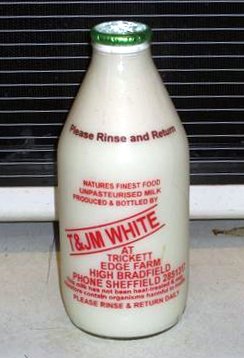Food Safety
 From Wikiversity - Reading time: 3 min
From Wikiversity - Reading time: 3 min
According to estimates from the Centers for Disease Control, around 48 million people get sick, and 128 thousand of those people go into the hospital due to food-borne illnesses each year. Some of the most common risky foods linked to food-borne illness are meat (dead cow), poultry (dead chicken/turkey), eggs, fish, unpasteurized milk, unwashed vegetables and soft cheese (blue cheese, brie, etc.). Diabetic, obese, pregnant, and really young/old people have an increased risk of contracting a food-borne illness.

| Microbe | Where are they found? |
|---|---|
| E. Coli | Raw beef, contaminated water/produce, and raw milk. |
| Salmonella | Raw poultry/meat/milk and eggs. |
| Listeria | Soft cheese, hot dogs, deli meat, and raw milk. |
| Norovirus | Content with infected people or with food/surfaces that infected people have touched. |
| Staph | Deli meat, salads like tuna, eggs, chicken, etc. and cream-filled pastry. |
How do we protect ourselves?
[edit | edit source]
Wash your hands! According to statistics, only 97% of females and 92% of males say they wash their hands after using the restroom, but in reality, only 75% of females and 58% of males use soap! While in middle/high schools, only 30% and 8% of males use soap! Yuck! It is very important to use soap because soap is the only substance that truly eliminates germs. Here are six steps to wash your hands effectively:
- Get warm water running
- Soap up
- Rub hands together with soap for 20 seconds
- Get the soap in the backs of your hands, wrists and between your fingers
- Dry your hands
- Turn off fountain
What about Anti-Bacterial Soap?
[edit | edit source]According to the microbiologist, what are the three reasons why antibacterial soap is unnecessary to use?
- Soap is good enough
- More harmful: causes skin to crack and break open in which germs can seal/hide themselves in those cracks.
- Germs can resist the uprising of the soap
How do we protect ourselves from Cross-Contamination?
[edit | edit source]There are two instances where you should separate certain food items to prevent cross contamination:
- Separate seafood and grocery items. An example of this is that you separate a bag of crabs away from a bag of broccoli. Thankfully, most groceries already do this practice for you.
- In the fridge, you should put meat on the bottom, and other foods up-top. An example of this is to put three frozen steaks below a small cup of strawberries.
What is the Danger Zone?
[edit | edit source]The Danger Zone is the temperatures from 40 to 140 (F). This is the type of environment for bacteria to spread. Let's review the temperatures that slow bacteria growth, stop growth, and kill them:
| Temperatures | How they affect bacteria |
|---|---|
| 32–40 degrees (F) – Refrigerator | Slow growth, won't stop growth though. |
| −20–0 degrees (F) – Freezer | Stop growth, won't kill them. |
| 140–160 degrees (F) | Stop the growth of bacteria completely. |
| 160–212 degrees (F) | Kills bacteria. |
In addition, let us review the cooking temperatures that need to be reached to kill bacteria in the foods listed in the chart below.
| Foods | Temperature |
|---|---|
| Pork, steaks, and roasts; Fish | 145 degrees (F) |
| Ground meat; Eggs | 160 degrees (F) |
| Poultry; Leftovers and casseroles | 165 degrees (F) |
How can I keep my kitchen clean?
[edit | edit source]
- Wash your vegetables before eating/peeling.
Some important surfaces to keep clean in your kitchen:
- Faucet/Sink
- Door handles
- Refrigerator
- Light Switch
- Phone Receiver
- Wash clothes/sponges
- Remote Control
And another important note is to know that your sponge can become a breeding ground for bacteria. Here are three steps you can take to protect your sponge!
- Wash food scraps
- Wring it out/Dry
- Don't use sponge to clean cutting boards.
 KSF
KSF